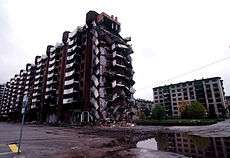Grbavica (Sarajevo)
| Grbavica | |
|---|---|
| Neighborhood | |
|
Residential high-rise buildings on the side of the Miljacka river | |
| Country | Bosnia and Herzegovina |
| Entity | Federation of Bosnia and Herzegovina |
| Municipality | Novo Sarajevo |
| Time zone | CET (UTC+1) |
| • Summer (DST) | CEST (UTC+2) |
Grbavica is a quarter of the city of Sarajevo, Bosnia and Herzegovina. Today it is part of the municipality of Novo Sarajevo and administratively distinguished between Grbavica I and Grbavica II.
The area was developed as a new residential neighbourhood by the authorities of Socialist Yugoslavia, on the west back of the Miljacka river. Grbavica I, between Zagrebacka ulica and the Miljacka river, besides residential building hosts the Forestry Faculty of the University of Sarajevo (Šumarski Fakultet), the Kovačići Franciscan monastery (Franjevački samostan), the Jordanian Mosque (Jordanska Džamija, 1996),[1] two primary schools (OS Kovačići, OS grbavica I) and the Netherlands embassy. On its north-west corner the new British embassy to Bosnia and Herzegovina has been built. Grbavica II, between Grbavica I and Hrasno, hosts the Grbavica shopping centre and the Ummu Arif Zabadne mosque. South of Zagrebacka ulica are the Grbavica Stadium, home of FK Željezničar, and the Catholic Church of St.Ignatius (Crkva Sv.Ignacija Lojolskog).
During the 1992-1995 war, Grbavica was occupied early by the Army of Republika Srpska and remained under Serb control throughout the siege. From the tall residential buildings by the Miljacka river, Serb snipers target the Sarajevo populace along Sniper Alley. During the Dayton negotiations, Milosevic was ready to give back Sarajevo to the Bosniaks, but wanted to retain Grbavica up to Snipers Alley. Alija Izetbegovic refused, saying that "Sarajevo without Grbavica cannot exist"[2]
The neighbourhood, looted and destroyed, was restituted to the town following the Dayton Accords; Bosnian Serb policemen left the area on 18 March 1996. In the two weeks before, the RS leadership from Pale ordered all Serbs in the area to burn their flats and leave the town, broadcasting by radio precise instructions. Arsonists from Pale roamed the streets, threatening the population - including Sarajevo Serbs who could have been willing to stay - to comply with orders. Gorinko Klickovic, head of the Bosnian Serb resettlement office, had declared that "We must not allow a single Serb to remain in the territories that fall under Muslim-Croat control". IFOR forces did not intervene to stop the attacks (which included cases of rape and killing of Sarajevo Serbs by RS troops) claiming that the Serbs "have the right to burn their own houses", nor did they protect Bosniak fire-fighters, willing to intervene. "We're seeing a multiethnic Bosnia being flushed down the toilet", decried UN official Kris Janowski at NATO/IFOR inactivity. The episode, with the resettlement of Sarajevo Serbs elsewhere in the RS (including Bratunac and Brcko) was later used by the RS leadership to impede the return of Bosniak refugees in those areas.[3]
The Bosnian film “Grbavica” was based on events that happened in the city during the Bosnian War.
Notes
- ↑ Grbavica I Dzemat
- ↑ Richard Holbrooke, To end a war, Random Hose 1998, p. 292
- ↑ Richard Holbrooke, To end a war, Random Hose 1998, p. 335-6
| Wikimedia Commons has media related to Grbavica (Sarajevo). |
 Serb soldiers toasting in occupied Grbavica, 1992
Serb soldiers toasting in occupied Grbavica, 1992- View of Grbavica, a neighbourhood of Sarajevo, after the war ended
- Downtown Grbavica in March 1996
 Destroyed residential buildings in Grbavica, 1996
Destroyed residential buildings in Grbavica, 1996- The Maniacs Graffiti at Grbavica stadium
 Panoramic view of Grbavica Stadium
Panoramic view of Grbavica Stadium- Winter panorama of Grbavica today, with an orthodox church in the foreground and the British embassy in the background
.jpg) Winter scene at Hamdije Čemerlića at Grbavica
Winter scene at Hamdije Čemerlića at Grbavica- Winter scene at Grbavica on February 5, 2012
- Residential high-rise buildings on the side of the Miljacka river
